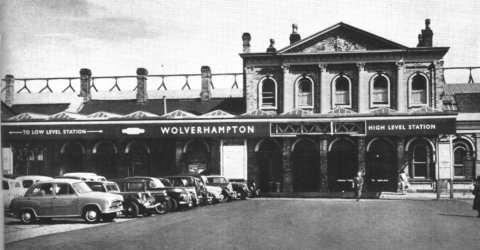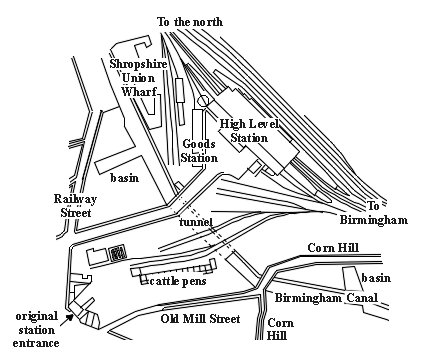 |
Rails In Wolverhampton - The Early Years
by Bev Parker |
 |
|
Queen
Street Station Wolverhampton
The Shrewsbury & Birmingham Railway purchased the site
on 29th September
1847. The site originally consisted of small industrial buildings, houses,
and a part
of the canal. The building was designed by Edward Banks who was architect
for
the railway company, the tender for construction was placed on 9th March
1849. |

The High Level Station in the early 1960's
just before demolition. It was re-built as
part of the electrification scheme. |
The initial buildings consisted of the main station itself and a grand
entrance building
situated at the end of a 220yard long drive at Five Ways. It had four
arches, the
centre two were for carriages, and the outer two for pedestrians.
Above the
entrance
were the offices and boardroom for the railway company, and at each side was
a row of shops. |
| The building opened on 10th October 1849. Work on the station was
delayed because a decision was made to divert the canal, and it finally
opened on
24th June 1852, but even then work on the refreshment room hadn't started.
It was a
handsome white brick building, originally known as Wolverhampton General
station,
but renamed Queen Street station in September 1853, because the entrance
building
faced Queen Street. |
Even in 1853, work was in progress on the GWR's station and so not
surprisingly
Queen Street became known as the High Level station, and the GWR station
became
known as the Low Level.Queen Street Station was officially renamed High
Level Station on 1st June 1885.
When the Shrewsbury and Birmingham Railway joined
the Great Western Railway on 1st September 1854, the Great Western used the
offices in the entrance building as its goods department. This continued
until 1st
March 1859 when the Great Western sold its half share in the station
buildings to
the London & North Western Railway who owned the other half. The Midland
Railway also began to use the station from 1st September 1867. |

Queen Street station after the 1884 enlargement. |
| The station soon became a victim of its own success as the facilities
were
inadequate for the large numbers of passengers that were using it. In the
1870's
about 120 passenger trains and 50 goods trains called there daily. In 1876
the total
number of passengers that used the station was 936,026.
It got so bad that
the town
council complained about the lack of facilities. The main problems were a
shared
booking office and refreshment room, lack of waiting rooms on the up
platform, low
and narrow platforms, and a dismal subway which connected the platforms. The
subway was so bad that it encouraged people to cross on the lines, and
several were
killed in the process.
The London & North Western drew up plans for the
station's
improvement and included them in a Bill in 1876. This was successfully
opposed by
the Great Western because the new buildings would have been built across the
public's approach road to the Low Level station. The plans for improvement
were
further delayed by the council's work in 1883 which involved a new direct
approach
road to the station. In 1884 the enlargement finally took place, and
included the
tunnel allowing public access from the High Level to the Low Level station,
and the
arcade known as the colonnades.
Although the station saw the LMS grouping in 1923, and the formation of
British Rail
in 1948, nothing much changed until its demolition on 25 January 1965 as
part of the
electrification scheme. The original gateway building still survives having
gained grade
2 listed status on 3rd February 1977. It was purchased by the town
council in 1986
and work began on 17th May 1988 to restore and convert it to its present
totally
appropriate use as the entrance building for the bus station.
 |
Return
to the
previous page |
|
|